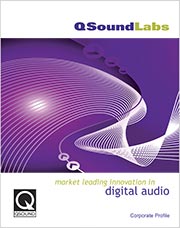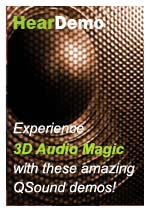
QSound Competitive Advantages
More Choice
Since the pioneering development of the positional 3D audio process for speakers, QSound Labs has gone on to create the most comprehensive suite of 3D audio processes available, with superior solutions for every conceivable scenario. By offering such a wide suite of audio processes we can leverage this experience to help reduce the cost and resources required for our customers.
Better Audio Performance
All QSound 3D audio processes are fine-tuned by skilled audio engineers for the most natural, pleasing sound experience possible. QSound 3D audio is characterized by superior focus and correct frequency balance (without coloring the audio), worthy of professional audio applications.
QXpander, for example, is a high-fidelity spatial processor – no more, no less. QXpander is designed to maintain the frequency content of the original signal, and to respect the intentions of content creators by preserving the integrity of the original image information, within which individual elements (instruments, voices) maintain their relative positions, focus, and coherence.
Competing processes can tire the listener with heavy-handed filtering that serves mainly to distract from muddy spatial performance and smeared imaging. In contrast, the sound stage produced by QXpander is more natural-sounding than plain stereo, and perceptibly alleviates listener fatigue, permitting comfortable and satisfying long-term use.
More Robust Algorithms
QSound’s speaker-targeted 3D processes are much more forgiving in the area of speaker/listener geometry than crosstalk cancellation systems. This means a much larger effective listening area and a great deal more flexibility in the placement of the speakers. Standard stereo audio gives the listen a very small “sweet spot” for true stereo listening. QSound offers a similar sweet spot for the best expanded audio effect but will also enhance the listening experience for each other person in the room regardless of their position relative to the speakers.
An additional benefit of the extensive acoustic design effort underlying QSound algorithms is their robustness in band-limited situations such as mobile audio applications. Though high frequencies are limited by low sampling rates, and compact multimedia speakers limit bass response, QSound algorithms continue to create excellent effects.
Higher Efficiency, Scalability
The efficiency of QSound’s speaker algorithms is first due to the fundamental method of their derivation. The approach taken by competing speaker 3D processes, i.e. the application of crosstalk cancellation to binaural synthesis, is by nature inefficient. Furthermore, the efficiency of all QSound 3D algorithms is due to a thorough understanding of the relative importance of various independent factors contributing to the net result. This has made it possible to derive from a ‘gold standard’ algorithm a family of lower overhead versions each exhibiting the most effective possible performance within their respective budgets.
Finally, QSound is a customer and technology focused company whose designers have a reputation for implementing a given algorithm by the most efficient method. Signal processing routines are written in hand-tuned assembly code by specialists adept at squeezing maximum value from each machine cycle.
Flexibility and Speed of Implementation
QSound’s extensive software engineering experience means that algorithms are readily available on numerous platforms including popular DSP’s and leading personal computer CPU’s. Custom ports or custom features may be quickly provided and our customer support is highly acclaimed. In situations where digital processing is available, an algorithmic solution generally provides the most flexible and cost-efficient solution.
A growing suite of integrated circuits is available through our silicon partners for use in products that do not involve programmable digital processors.

